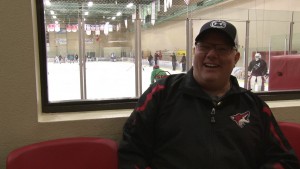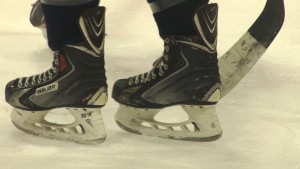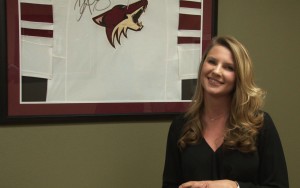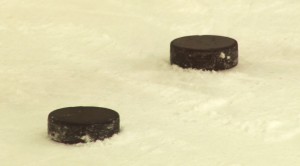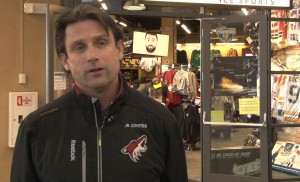- Slug: concussion risks in youth ice hockey, about 2,000 words.
- Tip box below
- Video available here
- Photos available (thumbnails, captions below)
By BLAKE BENARD
Cronkite News
SCOTTSDALE – Michael Slavik is all smiles as he walks to the ice with his teammates.
Slavik is a mother of 15-year-old twin boys who play club ice hockey. On a Friday night in Scottsdale, she’s watching her son Michael return to regular play.
“We were in Nashville when it happened,” Stephanie Slavik said.
During a normal travel hockey game in December, Michael Slavik sustained a concussion that left him with severe headaches and tiredness for weeks.
He isn’t alone.
As with a majority of youth sports, there is growing concern surrounding concussions in youth ice hockey, spurring some changes in Arizona youth leagues and concerns that reforms do not go far enough.
“In hockey, you can certainly get head injury to the head just as bad as in football, for sure. And people move way faster than you could ever move in football because you’re on skates,” said Dr. Richard Wennberger, a neurologist with Toronto Western Hospital in Canada.
NHL former players suing for change
Concerns about concussion risks in major league and youth sports leagues started with the NFL, which was forced to change rules surrounding professional football play after findings of by the medical community of CTE, a degenerative disease, in former players. A class-action lawsuit by former players led to a multi-million dollar settlement with the league.
Last year, 29 former National Hockey League players filed a federal class-action lawsuit against the league, claiming that the league failed to protect them against the risks of repeated head trauma during their careers. More NHL players later joined the suit, with nearly 100 now suing their former employer and accusing them of not protecting them from traumatic brain injuries.
Recently, as part of the lawsuit investigation, hundreds of emails between NHL officials were unsealed that suggested some NHL officials knew about the potential hazards of the game and were debating whether to cut down on fighting, according to media accounts including The New York Times and The Globe and Mail.
The concussion discussion has moved to young players who are in the early stages of their hockey careers, including Arizona.
Young players, high concussion risk
Parents, coaches and the medical community are looking at concussion risk among young hockey players, who start on the ice in Arizona as young as 8 years old.
According to an annual report by USA Hockey, which oversees club and high school play, there were 7,329 youth hockey players during the 2014-2015 season. More than a third – 2,764 – of players are 14 years old or younger.
The report does not contain the numbers of players who sustained concussions and the specific numbers are not readily accessible to the public. Even in Arizona, the Banner Concussion Center does not keep numbers on youth hockey concussions.
Experts say the younger the child, the higher the concussion risk. Especially in a sport where falling on ice, hitting the boards or being struck by a puck is common.
Younger ice hockey players have a significantly longer recovery time than post-adolescent athletes, according to a January article in The Journal of Pediatrics. Researchers recommended more physically mature youths be discouraged from playing with pre-adolescent players.
“Their brains aren’t fully mature yet and while they’re still in the process of undergoing changes, that disruption to the brain functionings may have longer lasting effects,” Dr. Wennberger said.
In a concussion, a player’s brain is slammed against the skull, leading to symptoms such as nausea, headaches and dizziness. Long-term effects of traumatic brain injury can include memory problems, personality changes, language impairment and interference with the ability to plan and solve problems. Medical autopsies on the brains of some former professional football players showed CTE.
Ice hockey leaves the players vulnerable, experts said.
“Whether by accident or more often by design, there can be some very high speed and impactful collisions,” Dr. Wennberger said. “And you can get hit in the head with the puck going 110 mph.”
A young player’s concussion
Stephanie Slavik was born in Canada, where ice hockey is the national winter sport. Hockey is in her blood. That’s trickled down to her twin sons, who are in a club youth hockey program in Scottsdale.
Michael sustained a serious concussion in December, and the road to recovery was difficult. His mother, Stephanie Slavik saw a side of the injury less visible to her son’s coaches and fellow players. It affected Michael’s daily life.
“He was never in a position where he couldn’t finish school, but he definitely had headaches every day coming home,” Stephanie Slavik said.
Still, Stephanie Slavik said, it’s frightening how easily concussions can be overlooked. Michael and his family did the right things. After he failed an initial baseline concussion test in December, they held him out of hockey until the headaches and tiredness petered off. Currently there is no ‘cure’ for concussions. Resting and waiting for the symptoms to go away is the best option.
Still, when Michael skated back on the ice a month after his injury, he wasn’t OK.
“We thought he was perfectly fine. And all of a sudden he goes into the rush of a skate, and he ends up having symptoms,” Slavik said.
After his recurrence, Michael went to a doctor and had a CT scan that came back clean. Still, the doctors kept him out for another couple weeks just to be safe. Michael eventually returned to practices but was still limited to no contact for two more weeks before being allowed to play in games.
“As a parent going through it definitely was a learning curve,” Stephanie Slavik said.
Michael finally returned to the ice after spending more than six weeks recovering from his concussion.
An intense physical game
Hockey revolves around intense physicality. Players skate at high speeds while fighting for the puck, using sticks, hands, and their body for any advantage they can get.
Body checking carries the biggest potential for injury. It involves a defensive hockey player disrupting the offensive athlete when he or she has control of the puck, sometimes with the stick and other times with the body. The aggressive motion can lead to players shoved onto the hard surface of the ice or along the boards on the wall.
Medical experts said body checking is especially risky for young people, whose brains, bones and muscles are still developing. And, the Journal of Pediatrics study noted, 13 to 18-year-olds grow at different rates. The bigger the player, the bigger the hit, the more potential for injury.
“Athletes should compete in leagues grouped by relative age and be discouraged from ‘playing up’ on varsity teams,” the study recommends.
Reforms for ice hockey players
Mindful of the concussion risk, USA Hockey in Arizona raised the age allowance for body checking from 11 years old to 13 years old in recent years.
“Up until five years ago, they would start their checking at 11. That’s been a big difference,” said Mike DeAngelis, director of the AAA Elite Program for the Jr. Coyotes in Arizona.
The Banner Health Concussion Center often deals with athletes suffering from a concussion.
“I think USA Hockey has done a great job in trying to promote proper training in youth hockey players,” said Sarah Schodrof, an athletic trainer with Banner Health.
All youth hockey clubs under USA Hockey are comprised of Mite, Squirt, Peewee, Bantam and Midget divisions. The youngest division has players 7 to 8 years old. DeAngelis said the club discourages the “playing up” mentality that would put younger, more talented players into divisions with older, more physically mature players. But it’s a recommendation, not a requirement.
Baseline concussion tests in high schools
In high school programs, also run by USA Hockey, every player must go through the mandatory Baseline Concussion Test prior to a season of play.
“It’s a quiet room where the kids do all these online testing. It’s memory, it’s reflexes, things like that. It takes about a half an hour or so. Then it records a baseline value. That happens before they set foot on the ice,” said Mike Steffans, a director with the Arizona High School Hockey Association.
When a concussion is suspected, the high school athlete retakes the same baseline concussion test and the physician compares the two results. A significant difference could indicate a concussion.
If a concussion is confirmed, the athlete is monitored by their physician until they are cleared to return to play.
“Coaches can help athletes by sticking to that gradual return to play progression and helping us verify that they’ve gone through it and they are symptom free while returning to play,’ said Schodrof, the athletic trainer for Banner.
Club hockey is different. For example, a club program like the Jr. Coyotes recommend taking a baseline concussion test before the season, but do not make it mandatory. There is also no specific protocol if a concussion is suspected. It’s more like unwritten rules that most coaches, referees and parents follow. However, all coaches do get concussion certification to help recognize symptoms on and off the ice.
“Any type of mention of those symptoms after that contact, the player is done for that session and typically goes to get concussion tested,” DeAngelis said.
Once a player is removed, the parents are responsible for making sure the athlete is tested for a possible concussion. This leads to a gray area.
“The parents always have the final say. The coach can pull a player if he wants. A lot of times, the player will try to hide the injury because they want to get back in there,” Steffans said. “The parents are the ones that will be taking the kid to the doctor, not the coach or the team manager.”
Some parents might think the concussion symptoms are not significant and fail to get the athlete tested. But the Jr. Coyotes teams won’t let a player back on the ice unless they have a written note from a doctor showing the athlete is cleared to play.
Considering more reforms
Some parents and medical experts say more reform is needed to protect young players. This includes preventing smaller players playing with big players, requiring annual concussion tests in youth club leagues and not allowing body checking at any age.
“What’s the point of ever having bodychecking in youth hockey, because 99.99 percent of kids playing aren’t going to make the NHL,” Dr. Wennberger said.
Still, Dr. Wennberger sees the benefits of learning how to safely check. He has noticed that if the kids aren’t taught how to properly body check at a younger age, they are more reckless when playing in the older divisions.
“People were skating into the boards without looking at what was coming behind them,” Dr. Wennberger said.
Some parents said allowing body checking at a younger age allows players to learn the sport safely.
“What they’ve also done is they’ve allowed more body contact at the younger ages without hitting,” said Tony Gabriele, a parent of a teen Jr. Coyotes player. “They’re teaching kids properly as younger kids so when they get to that age, it’s not a free-for-all, where they’re trying to send kids to the hospital.”
Stephanie Slavik added there needs to be more communication among medical professionals about a player’s concussion history.
“You enter that child’s name and you don’t know their prior history when it comes to concussions,” Slavik said.
Editor’s note: Sources in the Public Insight Network informed the reporting in this story through a partnership with the Cronkite PIN Bureau. To send us a story idea or learn more.
Talking to children about concussion risks
The Banner Concussion Center, a part of Banner Health, offers tips to children playing sports on its website that is also a good guide for parents concerned about concussion risks. The center website advises children that “feeling sad about being unable to play is understandable but their health is more important than any game.” The website says:
How do you know when to stop playing after you’ve bumped your head when you fell or someone or something hit you? Here are things to watch out for and to tell someone right away if:
- Your head hurts or you feel lots of pressure
- You feel like throwing up (vomiting)
- You’re feeling dizzy or woozy and can’t walk straight
- You can’t see properly and things are looking fuzzy
- The sun or any light feels too bright and you want to close your eyes
- Any noise is bugging you too much
- You feel very tired and can’t focus or feel confused
- You can’t seem to remember things
- Something does not “feel right” or is “feeling down”
Source: Banner Concussion Center website
^__=
